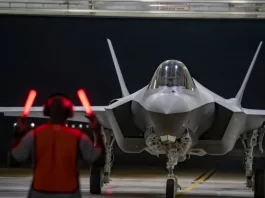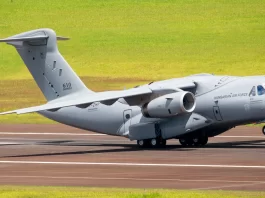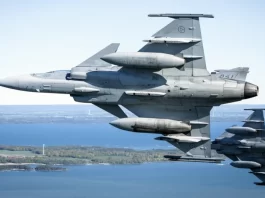The space-based recognition sensor is just one part of the U.S. Department of Defense’s space-based architecture for missile tracking, which also includes hypersonic and ballistic tracking space sensors, depicted here.
Lieutenant General Heath Collins, the director of the Missile Defense Agency (MDA), anticipates launching a new sensor by the end of the decade that can identify complex ballistic missile targets.
The Discrimination Space Sensor, or DSS, is a key component of the MDA’s vision for space-based missile tracking, Collins said in an interview with Defense News. This capability will complement the Hypersonic and Ballistic Tracking Space Sensor (HBTSS), which the agency developed in partnership with the Space Development Agency, launching its first two satellites in February 2024.
While the HBTSS was designed to track dimmer targets than traditional missile warning sensors, the DSS will help the Department of Defense distinguish missile targets from enemy countermeasures intended to obscure the identification of their advanced weaponry.
He stated that DSA is confident in its ability to enhance its recognition capabilities or introduce new capabilities in the future by using a space-based solution. Additionally, he stated that the subsequent phase involves the creation of a DSS prototype.
In April 2024, Collins informed lawmakers that the agency’s DSS had completed ground-based conceptual testing and was ready to move to the orbital demonstration phase. He told Defense News (August 21, 2024) that the sensor is planned to be launched by 2029.
The capabilities provided by DSS and HBTSS are part of a broader network of missile tracking satellites that the Department of Defense uses to enhance its ability to track both traditional ballistic missiles and maneuverable hypersonic weapons, which can travel at speeds above Mach 5. As adversaries like China and Russia demonstrate advanced missile capabilities, the range of orbital modes and spacecraft will provide the U.S. military with a more detailed and comprehensive picture of potential threats.
While the MDA developed the sensor technology for HBTSS, the Space Development Agency, part of the Space Force, deployed the satellites. Collins said that the relationship between the agencies would be similar for DSS.
He said that MDA intends to create this DSS prototype and subsequently collaborate with the Space Force to transition it to operational use in the future.
According to Collins, the MDA requested funding for DSS in its fiscal year 2025 budget, but the documents do not specify the amount requested.
While the agency works on the DSS prototype, it is also conducting tests to calibrate and demonstrate the capabilities of its first HBTSS satellites in orbit. In June 2024, the spacecraft tracked its first hypersonic launch—a test vehicle built to verify the system’s functionality. A second spacecraft is expected to fly later in 2024.
In addition to test ranges, the satellites are also tracking ongoing conflicts in the Middle East and Eastern Europe.
Collins stated that this technology is essential for the future control of any hypersonic weapon, as it allows them to capture whatever is occurring when they fly over Ukraine or Israel.






